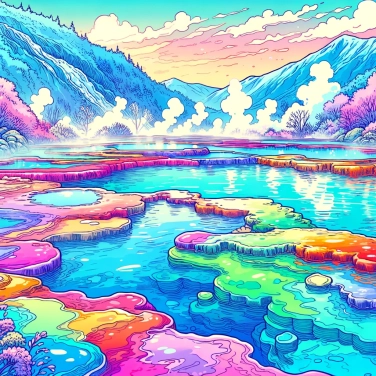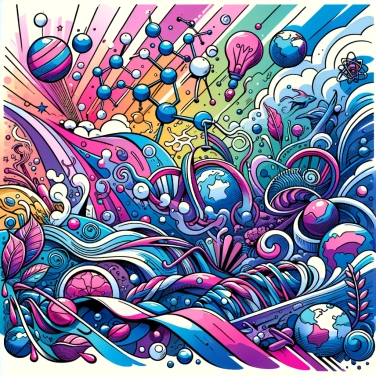Some hot springs have bright colors due to the presence of dissolved minerals such as sulfur, iron, or microorganisms like thermophilic bacteria, which reflect light in a unique way.

Beneath our feet, the heat produced by magma warms the water present in the rock or in underground aquifers. When this water penetrates deep through fractures and fissures, it heats up upon contact with the burning rocks, then rises to the surface under pressure, creating hot springs. Proximity to volcanic activity or geological faults promotes these hot water upwellings. This is exactly the phenomenon, also called geothermal activity, that leads to the eruptions and naturally warm water basins found in certain regions like Yellowstone in the United States or in Iceland.
The beautiful hues of hot springs often come from specific minerals dissolved in the water. For example, sulfur leads to a lovely bright yellow or pale green color, while iron oxides often give vibrant red and orange shades. The intense, almost unreal blue of some springs is due to the presence of silica, which diffuses and reflects light remarkably well. And you have surely admired those greenish or turquoise tones: that's often because of dissolved copper. This mineral cocktail, naturally present in the surrounding underground, is carried by the hot water as it rises to the surface. Simple, effective, and quite nice to see, right?
Certain microorganisms called thermophiles love hot springs, even when it gets seriously hot. These little creatures produce natural pigments in vibrant shades: yellows, oranges, reds, and even greens. For example, bacteria of the Thermus or Chloroflexus genus provide intense colors, while some algae also withstand high temperatures, displaying green or blue-green. The variety of shades observed largely depends on the types of microorganisms present, which are themselves sensitive to extreme conditions such as temperature or acidity. As the water becomes hotter or more acidic, the communities of microbes change, thus altering the visible hues on the surface.
The pH of a hot spring, in other words, its level of acidity or alkalinity, plays a key role in the color compositions that appear. The more acidic the water is (low pH), the more the hues will be dominated by light greens or yellows. Conversely, in more basic (alkaline, high pH) waters, one will rather observe orangish, pink, or reddish colorations.
As for temperature, it mainly influences the type of microorganisms capable of surviving in these extreme conditions. Around the hottest areas, close to the center of the springs, only a few very resilient thermophilic bacteria can live, often generating blue or transparent colors. A little further away, as the water cools toward the edges, a wider variety of microorganisms thrives, giving rise to vibrant hues ranging from bright orange to deep green depending on the species present.
When sunlight reaches a hot spring, it is both reflected at the surface and scattered underwater. This phenomenon alters how our eyes perceive the colors present. When mineral or organic particles are suspended in the water, they scatter the wavelengths of light differently. Some colors stand out more than others, for example, bluish or green tones when shorter wavelengths are scattered. Conversely, warm colors like yellow or orange often appear when the water scatters longer wavelengths. Thus, this subtle interplay between reflection and scattering creates these spectacular and varied hues that we love to observe in natural hot water pools.
In New Zealand, the colorful pools of Wai-O-Tapu are nicknamed the 'Artist's Palette' due to their diverse hues, ranging from turquoise blue to bright yellow, mainly caused by the presence of dissolved minerals and microbial activity.
The pink flamingos owe much of their vibrant color to the pigmented microorganisms they consume in the warm waters rich in algae and colorful bacteria, similar to those found in colorful hot springs.
Some thermophilic bacteria found in colorful hot springs have valuable industrial applications, including in medicine and biotechnology, as their natural pigments and resistance to high temperatures allow for interesting developments.
In some cases, yes: specific geological regions often contain certain common types of minerals (such as iron, arsenic, sulfur), which promote certain color tones. However, the final color also depends on specific local conditions, such as temperature, pH, and surrounding microbial life, making accurate predictions often difficult.
Not all colored hot springs are necessarily suitable for bathing: some may contain toxic chemical substances (such as arsenic) or have extreme temperatures. It is always important to seek information from reliable sources or local authorities before entering them.
Not necessarily. The majority of bright colors are natural and come from minerals, chemical deposits, or microorganisms like thermophilic bacteria. However, some unusual or sudden hues could indeed indicate contamination or pollution, so it is advisable to investigate the source carefully.
Sure! Here’s the translation: "Yes, temperature often directly influences the observed colors, primarily through the selection of thermophilic microorganisms adapted to certain temperature ranges. Thus, a very hot spring may host microorganisms and minerals that are radically different from those found in a warmer spring, resulting in variations in intensity and color hues."
No, not all natural hot springs necessarily have bright colors. The colors depend on the specific presence of dissolved minerals, the types of microorganisms present, as well as the pH and temperature of the water, which makes some hot springs particularly colorful while others are more dull and transparent.

No one has answered this quiz yet, be the first!' :-)
Question 1/5